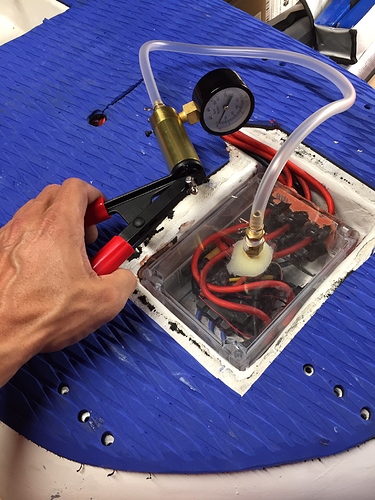My electrics are almost done and I would like to test my enclosures before going in the water. How do you guys do it? I have seen some air pressure stuff…
switch one wire coming outside the box by one tube and air pressure it to 0.5-1bar, look for leak with powder or spray water with soap (bubble), or smoke from electric cigarette 
What valve to use? And how can I pressure it?
I just put it in the water in the bath to test it 
I just didn’t power anything…
+1 for the bath
disassemble the electronic (depending on how confident you are) and leave it underwater for a while… the deeper the better…
filling the box with heavy metal stuff avoids it to float too much…
I epoxied a pipe fitting into each box which is closed with a small threaded plug with teflon tape while riding. I check before every ride if my ESC box in the back is tight. The battery box I trust now, it’s been solid. Have a hand vacuum pump (see pic) for quick checks and also a small converted volleyball pump for pressure which helps to track down holes with soap bubbles.
Thank you all. I will try to attach a kite pump into one of the cable glands and check the seal with soapy water. That way I don’t need an extra valve and I don’t need to take the electrics out. The VESC is “glued” down with thermal paste anyway, so I cannot remove it.
That’s an idea. But you will only have full piece of mind if you don’t open anything and mess with cable glands after checking. Also you won’t be able to check your last cable gland this way. I had several times where something was misaligned during final close, a piece of something got stuck on the seal or a cable caught while closing and I noticed only because of the vacuum test. But i am a bit paranoid, killed a Vesc before and my electric case is not that reliable, as mentioned no problems with the seahorse box.
Hmmm. Thats a hard decision.
I have been thinking about leak monitoring for some time now, but my battery box and my ESC box (empty icecream container ![]() ) have been waterthight until now.
) have been waterthight until now.
You could attach a bicycle valve and pressurize your box with just a quarter of a bar. If you reattatch the rubber cap it should be safe. Just make sure the valve can not be bent/broken off the box. My microcontorller has empty pins, so I will attach a pressure sensor and sound a alarm when it drops. I will use this pressure sensor I have floating around for an inital test when I find the time to do it. Testing is just much more fun than soldering and programming.
This video at 18 min 20 sec shows the watertight testing of a small ROV (capable of diving to 100m) full of electronics. Similar situation.
I welded a tapered hub on the bottom of the pod and threaded in a 1/8" NPT schrader valve. With this, I can apply low pressure with a bicycle pump. I spray soapy water and check for bubbles. I am finding the PLA is porous around the duct threads area, even with a 100% fill. Not sure what I am going to do. Maybe a bunch of coats of paint.
Epoxy coating with XTC-3D will help
